Subtotal: $
Checkout
Beauty for the Least of These
A unique depiction of the stations of the cross welcomes guests at the Lamb Center, a ministry to people experiencing homelessness.
By Ellie DuHadway
March 25, 2024
When picturing a homelessness shelter, what images come to mind?
One might picture fluorescent lights, cheap plastic chairs crowding around dated-looking tables, stressed volunteers dashing about, and, of course, those struggling with homelessness – receiving services, chatting with others, or trying to take a nap in spite of all the noise around them.
With that image in mind, the Lamb Center, a daytime shelter for the unhoused in Northern Virginia, might be surprising. At first glance, the center has all the trademarks listed above: a no-frills operation that serves hundreds of people each day with meals, laundry, showers, Bible study, and case management. Take a second look, however, and notice: there is art everywhere on the first floor, where the Lamb Center’s clients (who are called “guests”) receive services.
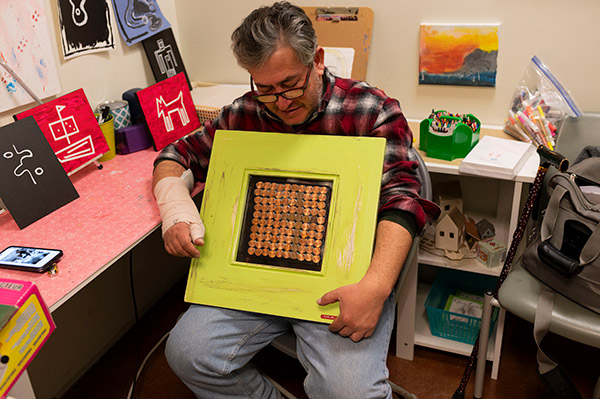
A guest at the Lamb Center displays his artwork. Photograph courtesy of Ellie DuHadway.
To the left of the front door, by the desks where guests check in, is a hodgepodge of drawings made by past visitors. A script verse of Galatians 5:22–23 – the fruit of the Spirit – is vinyled to the overhang above the kitchen. A cluster of paintings surrounds the elevator to the second floor, which houses administrative offices and the organization’s food pantry. One painting depicts Jesus mid-laugh, eyes crinkled shut in joy. Another shows a man in disheveled clothing kneeling on the ground and hugging Christ’s legs, a modern reminiscence of Rembrandt’s Return of the Prodigal Son.
Most curious of all are fourteen small illustrations in dollar-store chrome frames, interspersed all around the edges of the common space where guests sit. No bigger than postcards, these illustrations depict the stations of the cross – a series of fourteen images portraying events from Christ’s last day on earth before he was crucified. Stations of the cross, traditionally found in many Western Christian church contexts, are most commonly used for devotional contemplation during Holy Week in observance of Christ’s death and resurrection. These stations are printed onto silver paper, with a larger gold print at the end of the series titled, “Jesus is raised.”
The stations are reminiscent of German woodcuts in style: flat illustrations with sharp angles, textures created by line patterns, and expressive subjects. An accompanying booklet, available on request, includes the station illustrations along with narrow panels that illustrate a corresponding story in the Old Testament, a passage from Scripture, and a prayer.
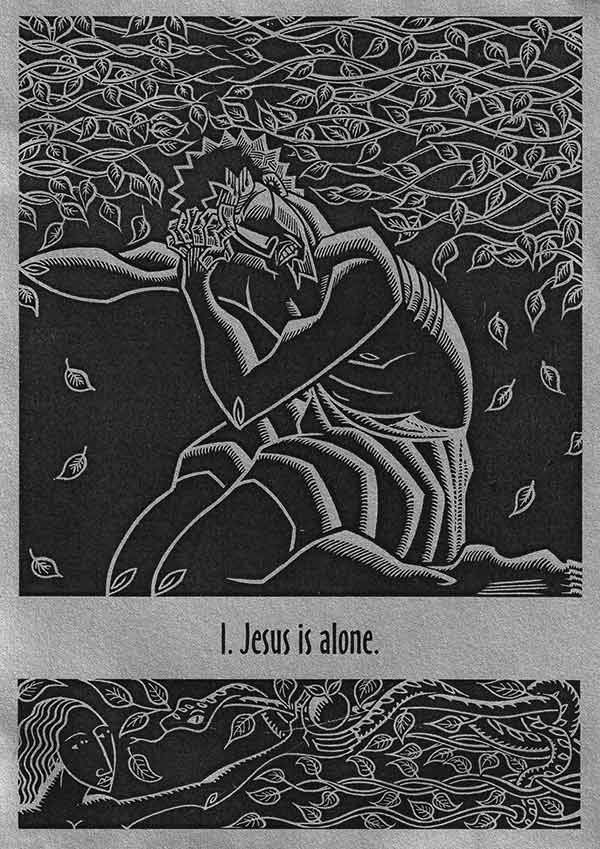
All artwork by Steve Schlossburg. Reproduced by permission from the Lamb Center.
The stations were created by Steve Schlossburg, rector of St. Matthew’s Episcopal Church in Richmond, Virginia. Schlossburg first encountered the Lamb Center – somewhat reluctantly – in the summer of 1998.
“I was the most disposable member at the church I was working for,” says Steve. “They came to me and they said, ‘Well, the Lamb Center is looking for a new director. Just go over there for a summer and we’ll pull you back out at the end of the summer.’ I didn’t know much about the Lamb Center, but I had volunteered in shelters from time to time, and I thought that wasn’t for me. But I went over there, and by the end of this summer, I was different. I applied for the director position there. That’s the last thing in the world I would have ever set out to do, but something happened to me.”
Schlossburg worked as the director of the Lamb Center for six years, running daily operations, creating occasional illustrations for their print newsletter, and leading Bible study twice a day.
“I first started reading the Bible because it was the director’s job to lead these Bible studies,” Steve recalls:
I hated it. Okay, I didn’t hate the Bible. I just thought the Bible was incredibly boring and impossible to understand. I would read it kind of like a high school freshman reads poetry for the quotable lines. And so when all of a sudden, I had to lead two Bible studies a day, I didn’t know what the heck I was doing. I would just find some story I knew I had heard before, ask the guests to read it, and then just start asking questions. And I learned the Bible by listening to these people suffering from poverty, mental illness, and addiction interpret Scripture.
And what I saw was some of these people eat it like bread; it matters to them. And they would fight with it, wrestle with it. They were just so honest…. It’s the kind of respect that allows a person to fight with something. If you can imagine respecting someone enough to fight with them. That’s what I saw at that table twice a day for six years. I came to believe this book is amazing. It’s real. It’s not just a bunch of religious mumbo jumbo. It’s about real life, real people.
When Schlossburg recognized the impact of the Bible on the Lamb Center community, he had a vision set for the stations of the cross. “I thought the stations were a natural fit for the Lamb Center because here, we’re surrounded by people who are experiencing the very suffering Jesus came to answer,” he says. “And part of his answer was to share the suffering of others. And so it just seemed like the stations are an act of walking beside him as he does that.”
Though he had no formal art school training and only made art as a hobby, he wanted to make something impactful and positive to surround the guests with. “The truth is that nobody wants to be there. If they had other options, they would be someplace else. So I know it was just a hard place to be for a lot of people, a joyless place. You don’t go there looking for joy. You go there because you’re in trouble. But you discover the joy.”
Beauty is not an extravagance, but a necessity.
In his illustrations for the Lamb Center, Schlossburg deviated from the traditional stations of the cross. The traditional stations begin the Via Dolorosa with Christ’s condemnation to death under Pontius Pilate. However, the Lamb Center stations of the cross begin with “Jesus is alone” – the night that Christ faced the weight of loneliness in the garden of Gethsemane. The Lamb Center stations also include Christ’s betrayal by Judas and denial by Peter before the station of his condemnation. Extrabiblical traditional stations are omitted, like Veronica wiping Christ’s face. This was an intentional decision on Schlossburg’s part: “In the absence of any other authority, the authority here will be the Bible. We don’t have a priest around here. We just let the Bible be the authority. So I wanted these stations to carry that authority.”
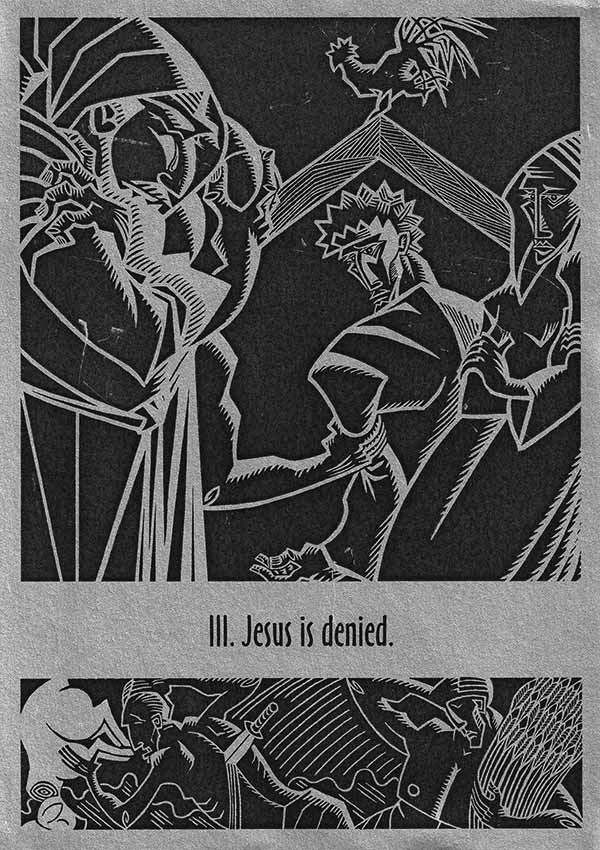
Schlossburg’s stations continue to impact the Lamb Center decades later. During Holy Week every year, the center’s Pastoral Director, Deacon Dave Larrabee, leads a prayer walk through the stations on Maundy Thursday, and leads guests, volunteers, and staff members alike in washing one another’s feet. This tradition began after Schlossburg’s tenure at the Lamb Center, carrying his artwork into new moments of devotion and connection to Christ beyond his original aspirations.
The walls of the upstairs hallways at the Lamb Center are a continuation of artwork made by volunteers, staff, and guests. There is also a dedicated art room upstairs, where Marcie Concepcion, a working artist and art teacher, volunteers at the Lamb Center one day a week by facilitating Open Art. During this one-hour session in the art room, any guests who want to spend time creating have time and space to do so.
“Specifically for this group of people, sometimes it’s just a break,” Concepcion says. “They may not want to be down there, elbow to elbow with everyone else at the table. Or sometimes they’re bored, or they’re curious. Sometimes, they wind up with an idea.” She recalls the stories of guests who attend Open Art. One newer guest reached an emotional breakthrough by spending time creating. Another guest attends Open Art each week. “He has a world in his head of concepts and ideas that he connects to because he is a creative. And he has no outlet other than that. I find that sometimes he’s living Wednesday to Wednesday.”
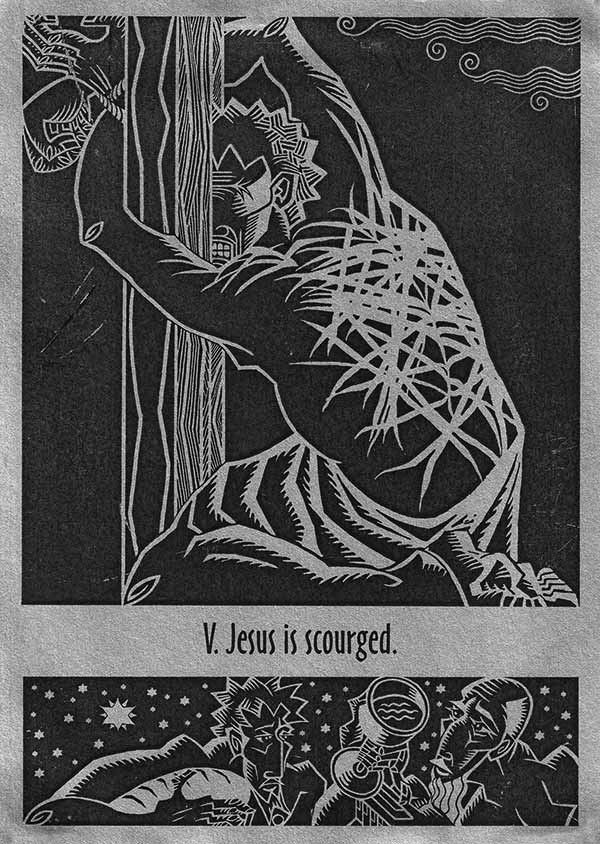
Though Open Art is not formal or clinical art therapy, Concepcion notes how much of a healing process these weekly sessions can be. “We don’t know who’s going to be here each week, and we don’t know how that dynamic is going to work, so we are trying to give them an opportunity to express themselves in whatever way possible. And if appropriate, we talk about filling the soul versus draining it. We can fill this hole with lots of things, but from my own practice, [creating] can be therapeutic for me – and for them.”
In the art room, Concepcion shares art pieces made by guests, explaining their unique perspectives on life and worship through the lens of their experiences. Some pieces are full of grief, displaying the trauma and loss that a guest has experienced; other pieces are hopeful and communicate messages of resilience.
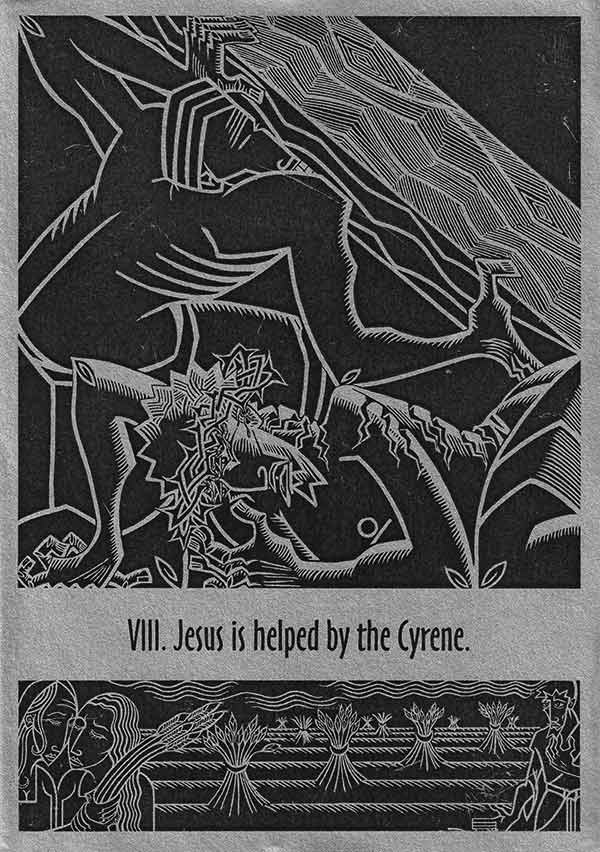
“I have to believe that it’s important,” says Concepcion. “I think it’s because the longing to connect with God is so much deeper than we can understand. And art is one of those ways that we touch the Creator, or get a glimpse of him. And that’s where we need to start.”
The Gospels are full of promises. One of those promises – cited less frequently – is that those who live in poverty will always be with us (Mark 14:7). Schlossburg says it well on the last page of the stations of the cross booklet, when describing the mission of the Lamb Center: “We have seen that it is not only for the sake of the needy that we are called to break bread with people experiencing brokenness. It is for the sake of the church too. Our relationship with this community enrichens our faith, multiplies our prayers, and enlarges our experience of the living God. Here we meet those despised by men, bearing enormous sorrows. With them, we discover our own brokenness. With them, we draw to the cross of Jesus.” The presence of art at the Lamb Center is a unique legacy for ministry to the unhoused. Artists past and present, volunteers, and guests show how those living in poverty need the arts as much as anybody, demonstrating that beauty is not an extravagance, but a necessity. Beauty is its own nourishment, essential for the flourishing of all people – even those who have been called “the least of these.” Perhaps especially so.
Already a subscriber? Sign in
Try 3 months of unlimited access. Start your FREE TRIAL today. Cancel anytime.







Rona Obert
The artwork of Mr. Schlossburg is wonderful. Are there booklets available?